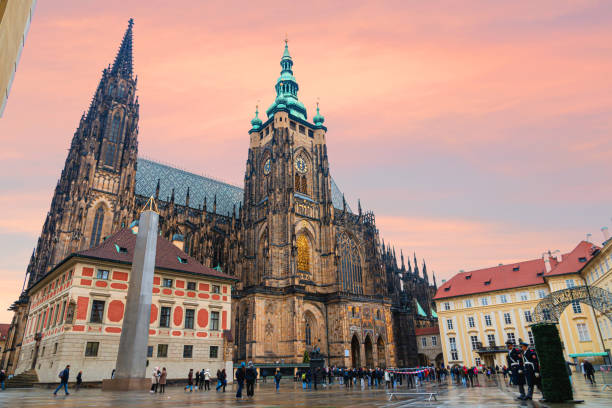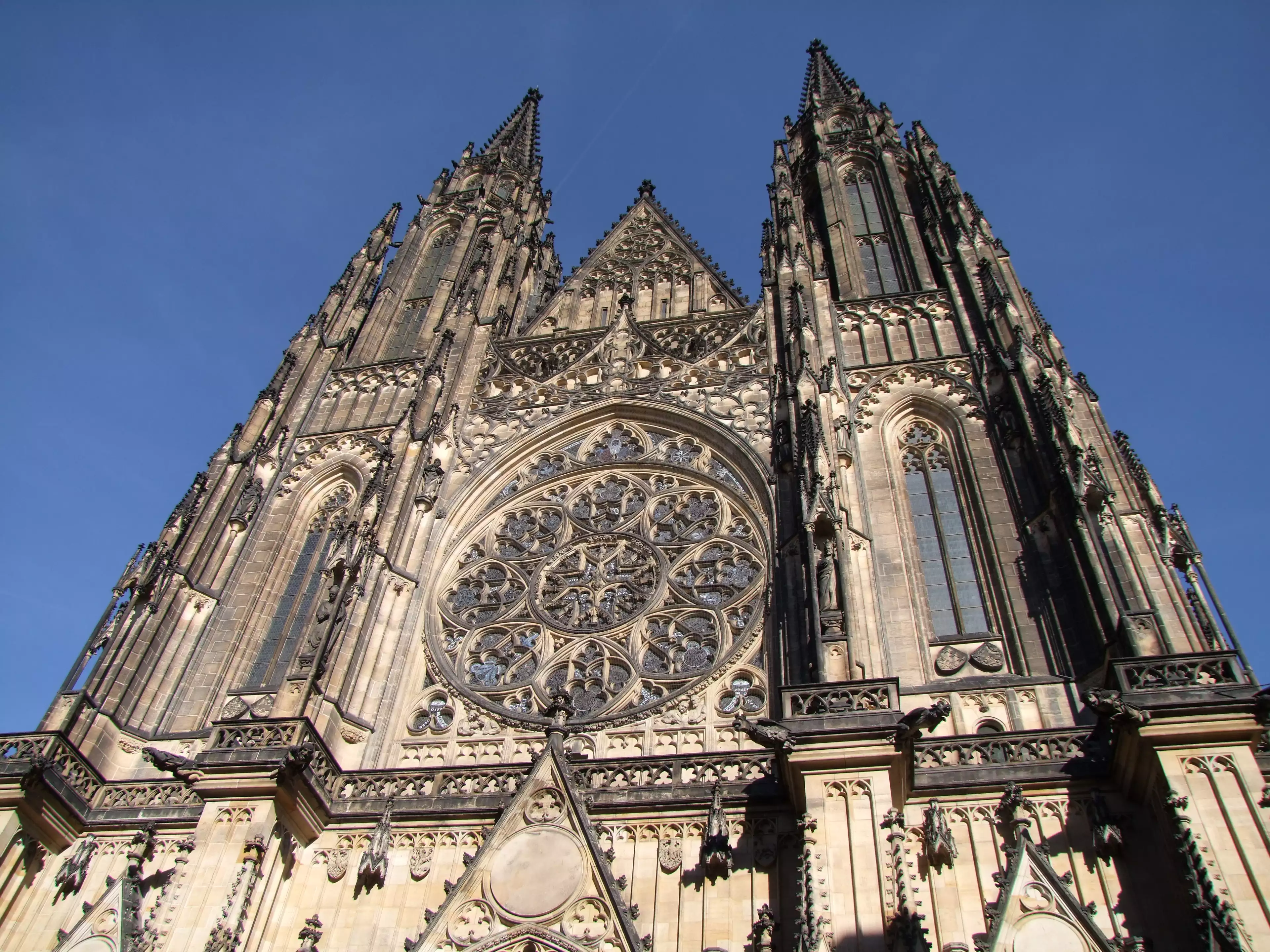Discover the majesty of 聖ヴィート教会(kostelsv。vita) in Prague, a Gothic marvel rich in history and artistic beauty. Explore its architectural wonders and cultural significance.
Introduction
St. Vitus Cathedral, also known as Kostel sv. Víta, stands as an unparalleled Gothic masterpiece in the heart of Prague. Nestled within the Prague Castle complex, this cathedral embodies the rich tapestry of Czech history, culture, and spiritual heritage. As one of Prague’s most iconic landmarks, its grandeur and historical significance draw visitors from around the world. The cathedral’s origins date back to the 10th century, making it a living monument to the evolution of architectural styles and religious devotion in the region.
Historical Origins and Early Construction
The origins of St. Vitus Cathedral can be traced to an earlier Romanesque church commissioned by Duke Wenceslas I of Bohemia in 925. This initial structure, though modest by today’s standards, laid the groundwork for what would eventually become a monumental Gothic cathedral. Duke Wenceslas’s vision for a grander religious edifice reflected his dedication to both his faith and his people. Over time, this early church evolved to accommodate the growing religious and political significance of Prague.
The Transition to Gothic Architecture
The transition from the Romanesque to the Gothic style marked a new era in the construction of St. Vitus Cathedral. In the 14th century, Emperor Charles IV commissioned the construction of the present Gothic structure. This period saw the introduction of innovative architectural techniques that defined Gothic architecture, including pointed arches, ribbed vaults, and flying buttresses. These elements not only enhanced the cathedral’s aesthetic appeal but also contributed to its structural integrity.
Construction Challenges and Innovations
The construction of St. Vitus Cathedral was not without its challenges. The project spanned several centuries, during which architects and builders encountered numerous obstacles. Despite these difficulties, the cathedral’s design continued to evolve, incorporating new innovations and technologies. The use of intricate stone carvings and elaborate stained glass windows became defining features of the cathedral, showcasing the artistic and engineering prowess of its creators.
Architectural Features and Design Elements
St. Vitus Cathedral boasts a range of architectural features that highlight the grandeur of Gothic design. Its soaring nave, adorned with intricate ribbed vaults and towering columns, creates a sense of awe and majesty. The cathedral’s façade, decorated with detailed sculptures and ornate carvings, serves as a testament to the craftsmanship of its builders. Additionally, the cathedral’s stained glass windows, which depict various biblical scenes and figures, add vibrant color and light to the interior.
The Role of St. Vitus Cathedral in Czech History
Throughout Czech history, St. Vitus Cathedral has played a central role in significant events. It has served as the site for the coronation of Czech kings and emperors, making it a key symbol of the nation’s royal heritage. The cathedral’s association with these historical events underscores its importance not only as a religious site but also as a cultural and political landmark. Its role in shaping the history of the Czech Republic cannot be overstated.
Significance of the Coronation Rituals
The coronation rituals that took place at St. Vitus Cathedral were elaborate and deeply symbolic. These ceremonies were not only important for the individuals being crowned but also for the people of the Czech lands, who viewed them as a reaffirmation of their national identity and continuity. The cathedral’s association with these rituals adds a layer of historical depth to its already impressive legacy.

The Artistic Legacy of St. Vitus Cathedral
St. Vitus Cathedral is renowned for its artistic legacy, which is evident in its numerous works of art. The cathedral’s collection of sculptures, paintings, and other artistic elements reflects the creativity and skill of the artists who contributed to its design. Each piece of art serves as a visual narrative, telling stories from the Bible and the lives of saints, and enriching the overall experience of visitors.
Exploring the Cathedral’s Stained Glass Windows
One of the most striking features of St. Vitus Cathedral is its stained glass windows. These windows, created by renowned artists, depict a range of biblical scenes and figures. The vibrant colors and intricate designs of the stained glass not only enhance the beauty of the cathedral but also provide a spiritual experience for those who view them. The windows serve as a reminder of the cathedral’s role as a place of worship and reflection.
The Cathedral’s Role in Modern Prague
In contemporary Prague, St. Vitus Cathedral continues to be a central cultural and religious landmark. It attracts millions of visitors each year, who come to admire its architectural splendor and learn about its historical significance. The cathedral’s role in modern Prague is a continuation of its long-standing tradition as a symbol of Czech heritage and spirituality.
Preservation and Restoration Efforts
Preserving and restoring St. Vitus Cathedral has been an ongoing effort, aimed at maintaining its structural integrity and artistic beauty. Various restoration projects have been undertaken over the years to address the effects of time and environmental factors on the cathedral. These efforts ensure that future generations will be able to experience and appreciate the cathedral’s historical and artistic value.

Visitor Experience and Attractions
Visiting St. Vitus Cathedral offers a rich and immersive experience for tourists. The cathedral’s vast interior, adorned with stunning artworks and historical artifacts, provides a glimpse into the past and present of Czech culture. Guided tours and informational displays enhance the visitor experience, offering insights into the cathedral’s history and significance.
The Cathedral’s Impact on Czech Culture
St. Vitus Cathedral’s impact on Czech culture extends beyond its architectural and historical significance. It serves as a symbol of national pride and identity, reflecting the country’s rich cultural heritage. The cathedral’s role in shaping Czech cultural traditions and values highlights its importance as a national landmark.
St. Vitus Cathedral in Popular Culture
The grandeur of St. Vitus Cathedral has not gone unnoticed in popular culture. Its striking appearance and historical significance have made it a subject of various artistic representations, including films, literature, and photography. These portrayals contribute to the cathedral’s global recognition and cultural relevance.
Future Prospects for 聖ヴィート教会(kostelsv。vita)
Looking ahead, 聖ヴィート教会(kostelsv。vita) faces both opportunities and challenges. Continued efforts to preserve and enhance the cathedral’s historical and architectural features will be crucial in maintaining its status as a premier cultural and religious landmark. Future developments and projects will play a key role in ensuring that the cathedral remains a vibrant and relevant symbol of Czech heritage.

Conclusion
聖ヴィート教会(kostelsv。vita) stands as a timeless symbol of Czech heritage and spirituality. Its Gothic architecture, historical significance, and artistic treasures make it a remarkable landmark in Prague. As a place of worship, history, and cultural expression, the cathedral continues to captivate and inspire visitors from around the world.
Read Also: Discovering Eagle Falls Washington A Comprehensive Guide

